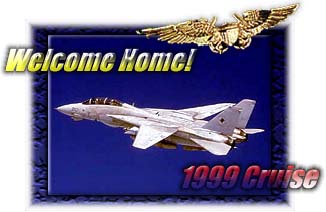 Welcome HOME! Welcome HOME!
published by the NAS Oceana Jet
Observer
On Tuesday, Sept. 21, the families of four NAS Oceana-based
squadrons from Carrier Airwing Eight - VF-14, VF-41, VFA-15 and VFA-87 - braved the rain
at Apollo Soucek airfield to greet their returning heroes. CVW-8 returned home two days
ahead of schedule due to Hurricane Gert. Both F/A-18 squadrons had departed from 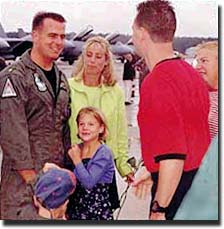 NAS Cecil
Field, Fla., which closed during their deployment under BRAC. VFA-15 and VFA-87 were in
the unusual position of having said good-bye to their families in one state and returning
home to them in another. NAS Cecil
Field, Fla., which closed during their deployment under BRAC. VFA-15 and VFA-87 were in
the unusual position of having said good-bye to their families in one state and returning
home to them in another.
USS Theodore Roosevelt (CVN-71) and CVW-8 departed
Norfolk in March with orders to proceed to the Arabian Gulf, after a short stop in the
Mediterranean, to relieve the Enterprise Battle Group. However, the crisis in Kosovo
erupted and plans changed.
By April 6 USS Theodore Roosevelt, Leyte Gulf,
Halybur-ton and Albuquerque had arrived in the Ionian and Adriatic seas to bring the full
and lethal combat power of the Theodore Roosevelt Battle Group to bear.
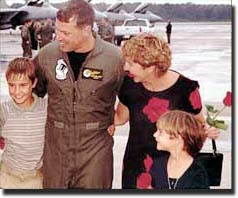 During the next 65 days and nights, CVW-8 aircraft would fly
more than 3,400 combat missions and log in excess of 12,000 flight hours delivering 800
tons of ordnance on military targets throughout the Federal Republic of Yugoslavia. After
65 days of intense combat operations, the Serbians decided that they had seen enough of
the Theodore Roosevelt Battle Group and signed the military technical agreement on June 9,
ending the armed conflict. During the next 65 days and nights, CVW-8 aircraft would fly
more than 3,400 combat missions and log in excess of 12,000 flight hours delivering 800
tons of ordnance on military targets throughout the Federal Republic of Yugoslavia. After
65 days of intense combat operations, the Serbians decided that they had seen enough of
the Theodore Roosevelt Battle Group and signed the military technical agreement on June 9,
ending the armed conflict.
The key to success throughout the conflict was
communication and the dogged determination of the battle group. During 65 days of intense
combat operations not a single ship, aircraft, submarine, or human life was lost in the
Theodore Roosevelt Battle Group.
On July 14, T.R. and CVW-8 arrived in the Arabian
Gulf to relieve USS Kitty Hawk of Southern Watch duties of enforcing the U.N. mandated
no-fly zone in Southern Iraq. Fours days later, on July 18, CVW-8 F/A-18s and F-14s
conducted their first strike in theater with precision guided munitions against an Iraqi
surface-to-air missile site about 200 miles south of Bagdad and an Iraqi military
communications site 150 miles southeast of Bagdad. The strikes marked the first time in
recent history that strikes from the same aircraft carrier have taken place in two
different theaters of operations during the same deployment.
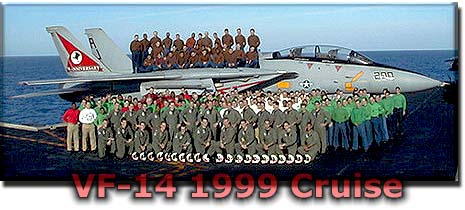
By the time USS Constellation relieved T.R. and
CVW-8 of Southern Watch duties on Aug. 27, T.R. and CVW-8 had completed more than 2,400
sorties. These sorties included eight separate combat strikes on Iraqi air defense sites
and more than 30 tons of ordnance expended.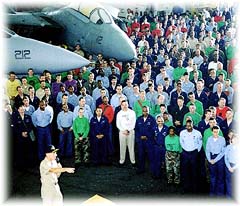
On Sept. 11, the Chief of Naval Operations, Adm. Jay
L. Johnson came aboard T.R. to address the crew. "From the day you sailed, people had their eye on the Theodore Roosevelt
Battle Group. Think of what you've done. You came to the Med. You roared into the
Adriatic. You did the Kosovo operation. You made the difference." Johnson said. |